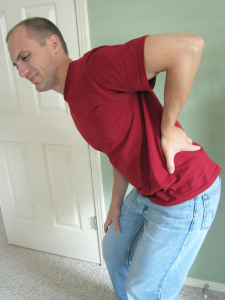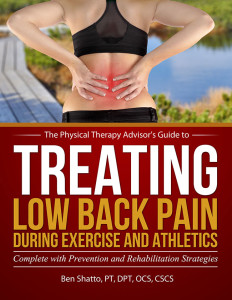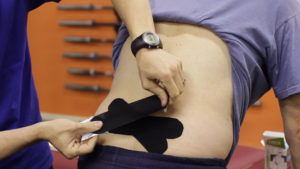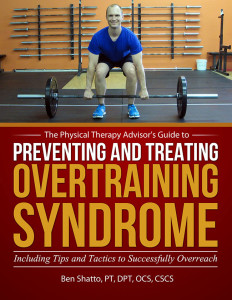I had waited all year for the City of Trees half marathon. My goal (as always) was to post a PR (personal record) for the event. Since it was a fairly flat course, I figured it would be a good opportunity to run fast (at least, fast for me). As part of my training protocol, I was squatting two days per week and working on general leg strength and cross training (practicing yoga) one day per week.

My back had been sore off and on for almost five years. Medical professionals didn’t offer me any specific reasons as to why. Neither chiropractic nor physical therapy seemed to help much, so I just ignored it. But not this day!
I had just completed my second work set of squatting at the gym. At the time, I wasn’t experiencing any notable back pain. I was on my second repetition and on my third set when my low back gave way. The weight came down and hit the rack safety rails! My back hurt, but worse, it felt unstable. I decided to leave the gym in shame. I picked up the weights I was using, but the pain began to worsen.
By the time I drove home, I could barely get out of my truck. I decided I was tough, so I took some ibuprofen and still went to work. By the time I made it to the office (about 10 minutes), I was in real trouble. I walked around for a while, and I took some Tylenol before I decided to go home. I got in my truck, but by then the pain was so bad that I couldn’t push in the clutch or hardly use the brakes. I really don’t know how I make it home that morning, but I needed help from my wife to get out of my truck.
 It only got worse from there. I went to lie on my bed. Again, another bad plan! An hour later when I needed to urinate, I realized I couldn’t even get out of bed! The pain was worse than anything I had ever experienced. After much struggle and help from my dad (who was called in to help), I was able to get upright, only to break out in a cold sweat, start shaking, and nearly pass out from the pain. Still having to urinate, I experienced one of the more humbling things I have ever done. I had to ask for help from my wife to urinate into a plastic bottle because I couldn’t get out of bed.
It only got worse from there. I went to lie on my bed. Again, another bad plan! An hour later when I needed to urinate, I realized I couldn’t even get out of bed! The pain was worse than anything I had ever experienced. After much struggle and help from my dad (who was called in to help), I was able to get upright, only to break out in a cold sweat, start shaking, and nearly pass out from the pain. Still having to urinate, I experienced one of the more humbling things I have ever done. I had to ask for help from my wife to urinate into a plastic bottle because I couldn’t get out of bed.
Long story short, I went to a doctor who diagnosed me with low back pain (LBP) from a lumbar strain and prescribed pain medication and a steroid pack. After many more days of pain, I was finally upright again.
A month later, I was ready to start back into my training, but frankly, I was nervous! My back felt weak, and I had no idea how much was too much. The worst part of it all: I’m a physical therapist! Shouldn’t I known what to do? It sure didn’t feel like it at the time.
The medication did mostly relieve the pain, but I had a chronically sore back that felt weak and unstable. I was performing physical therapy exercises and stretches. I was even using heat and electrical muscle stimulation (EMS).
My treatment wasn’t helping me that much. At least, not to the point that I felt I could get resume my training for my upcoming half marathon. All I wanted to do was to get back to training, but I was too scared to!
This experience started me down a path of study that changed my life. I realized how incompetent I had been as a physical therapist who treated others experiencing severe low back pain. I had new appreciation for those patients who wanted to get back to their sport and activity. I also realized that my prior physical therapy interventions were not preparing people to get back to sport nor most high level activities.
What do you do when you’re past the worst of the pain and want to resume training, but you don’t feel physically, mentally or emotionally ready? Your insurance money may be used up. The pain may have dissipated, but you’re still not sure how to progress through the next steps. What if it happens again? Can I train as hard as before? Am I really better? I have lost so many days of training, should I even compete in my event?
Often after a severe case of low back pain, you may be too scared to train like you did prior to the injury, and it turns out you should be! At least until you understand why low back pain almost always reoccurs and what you can do to prevent it.
The most common treatment strategies for low back pain are too general for most active individuals, weekend warriors, sport enthusiasts, CrossFitters, weightlifters, and runners. I have spent the past 11 years researching, studying, and refining best practices for treating LBP. I have combined research with known anatomical and physiological principles in order to develop very specific strategies for LBP prevention among active individuals. I have designed a complete guide and system to help you to prevent, treat, and manage LBP so that you don’t have to waste any training days because of ineffective treatment measures.
Treating Low Back Pain during Exercise and Athletics

In this complete self-treatment package, Treating Low Back Pain (LBP) during Exercise and Athletics, I share very specific strategies for LBP prevention among athletes such as sport enthusiasts, CrossFitters, weightlifters, and runners. These principles are helpful for anyone participating in athletics as well as those implementing a healthy lifestyle. You’ll learn how to address specific causes of LBP as well as the best practices on how to prevent and self-treat when you experience an episode of LBP. In this step-by-step LBP rehabilitation guide (complete with photos and detailed exercise descriptions), you will discover how to implement prevention and rehabilitation strategies.

In this package, you get an in-depth look at treating LBP with a 7-part series of instructional videos in which I address low back pain prevention during exercise; specific warm ups for exercise and activities; what really is the “core” and why it matters; treatment techniques (including how to apply Kinesiological tape); and long term management strategies. This includes nearly 60 minutes of actionable advice to prevent and treat LBP as it relates to active individuals, sports (such as running), and athletics.

In this BONUS eBook, Preventing and Treating Overtraining Syndrome, I show you how to recognize the risk factors and symptoms of Overtraining Syndrome (OTS). You’ll learn how to utilize prevention strategies to help you develop a personal training strategy that will allow you to push past your limits and prior plateau points in order to reach a state of what is known as overreaching (your body’s ability to “supercompensate”). This will speed up your results, so that you can train harder and more effectively than ever before! In addition, learn how to use the foam roller (complete with photos and detailed exercise descriptions) as part of a health optimization program, recovery program, rest day or treatment modality.
